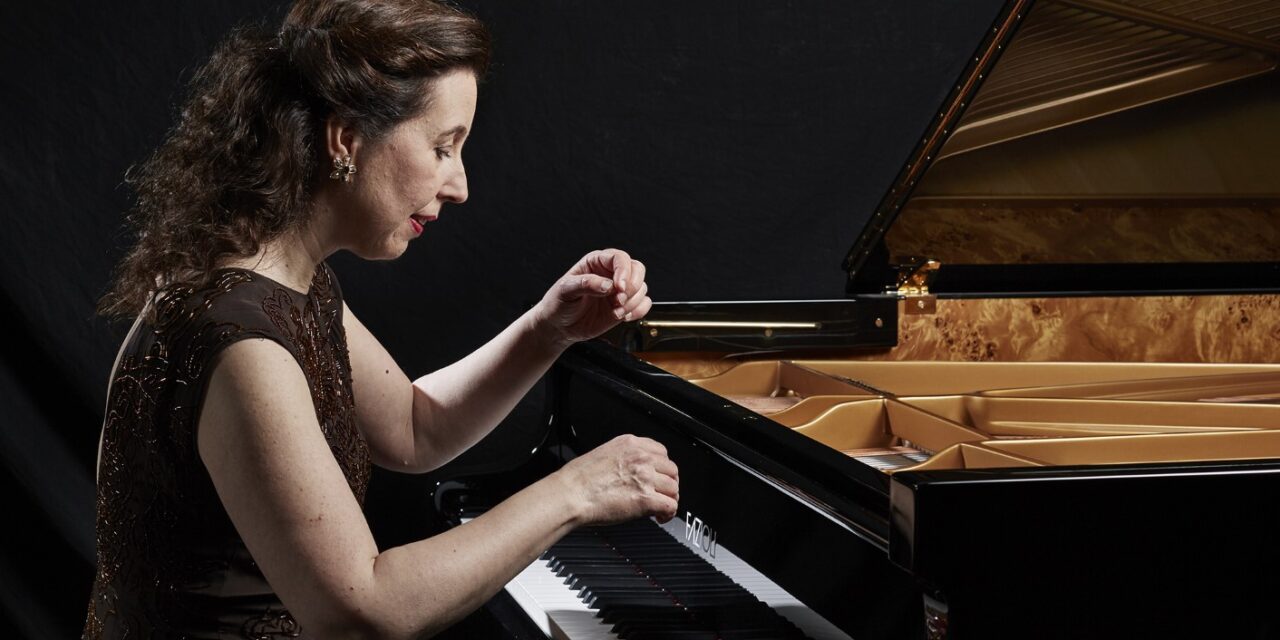Review by Mark Morris
photo of Angela Hewitt by Keith Saunders
Edmonton Chamber Music Society
Bach: Goldberg Variations
Angela Hewitt (piano)
Winspear
April 7, 2025
Once in a blue moon, one attends a concert where the most apposite thing to say is simply, “It was a privilege to have been there”. Canadian pianist Angela Hewitt’s concert at the Winspear on Monday April 7th, put on by the Edmonton Chamber Music Society, was just such a concert.
There was only one work, the music Hewitt is most associated with, Bach’s Goldberg Variations, BWV 988. She first performed them 50 years ago, in March 1975, in Lunenburg, Nova Scotia. In 1999 she made a celebrated recording on the Hyperion label (Hyperion 00602458135916), and made a second recording for Hyperion in 2015 (Hyperion 00602448795915). This performance in Edmonton was part of a tour to celebrate that half-century.
Bach is said to have composed the Variations for the young Johann Gottlieb Goldberg, harpsichordist to Count Hermann Karl von Keyserling, the Russian ambassador to the Court of Saxony. Keyserling was an insomniac, and liked to have Goldberg play for him when awake in the middle of the night. The variations were written at his instigation for Goldberg to perform in those small hours of the morning.
Hewitt plays Bach on the piano, following the lead of Canadian Glenn Gould. Gould’s famous recording in 1955 cemented the idea, in North America at least, of playing them on the more modern instrument (he re-recorded them in 1981). Bach had specified a two manual harpsichord, where in a number of the variations the second manual allowed lines to cross over, with the result that considerable virtuosity is needed in those passages on a piano.
Bach was, in fact, aware of the earliest pianos, having been shown one by Gottfried Silbermann and eventually becoming an agent for Sibermann’s instruments, but these were much softer and more limited in power than a modern piano. The main differences between a harpsichord and a piano, then and now, are that a harpsichord cannot sustain notes, and a piano can, and that a harpsichord has a fixed volume, while a piano has variable dynamics. The former plucks the strings, the latter hammers them.
The resulting sounds – and types of expression – are so great that it is invidious to compare performances of the Goldberg Variations on the two different instruments. Although it is now more common to encounter performances on the piano, I personally prefer them played on the harpsichord, because I find the type of sound of the harpsichord to better suit the music (though a tedious harpsichord performance becomes wearisome indeed). But it is Hewitt who has almost persuaded me otherwise, especially in the performance she gave on Monday evening.
She uses a piano that will be unfamiliar to most Edmonton music-lovers: she regularly travels with her personal piano, an F278 made by the Italian firm Fazioli. Alberta being far from her London home, the Fazioli she played in the Winspear was supplied by a Fazioli agent in Calgary. As Anne-Marie Petrov, CEO of the Winspear, pointed out in the opening comments, single instrument concerts are rare in the Winspear, but with the Fazioli in the acoustic sweet-spot in the centre of the stage, the scale seemed entirely fitting.
The Fazioli has a rich but bright sound, especially in the higher octaves, suiting the precision of Hewitt’s style. Her first recording, made on a Steinway (in what was essentially one take in the Henry Wood Hall in London, and played, as she always does, with all the repeats) was notable for its clarity, its virtuosity, its precision, and for its emotional thoughtfulness. Her second, on a Fazioli, added more expressiveness to the emotions (and around three minutes to the disc) – there seemed a greater sense of freedom. Now, in this Winspear performance, that freedom seems to have evolved further, while maintaining all the virtues that she brought to the work back in 1999.
What made it so special? Hewitt uses the advantages of the piano – diminuendos and crescendos, holding notes, and where appropriate the sheer power – but without losing touch with the sometimes metronomic aspects of Bach’s harpsichord writing. Every aspect of the interpretation – dynamics, tempi, phrasing – sounds not only so carefully judged, but just right, as if that’s how they were designed. Above all, Hewitt gets immersed in the wide-ranging expressiveness of the Variations, in the emotions she sees in them, and then she unravels them. There is a sense that the audience has melted away, leaving just the music: even in those virtuoso moments as one arm lifts and crosses over the other, it never seems for display, but simply out of the joy of playing. For all the dourness of the early variations, there is real joy, an impulse of the dance, in her approach, and as she goes into the later variations, you realize that that emotional content has been gradually building to the pianistic power she brings to Variations 29 and 30 – more climatic than in her second recording.
So much so that the music seemed to have ended, all passion spent. Then the long silence, and quietly, a small voice emerges for the reprise of the opening aria, but distant, as if reminiscing on it all – I was reminded of the aging Bilbo Baggins, sitting in a chair with his pipe at Rivendell, looking back on all the adventures.
And what adventures we had just experienced.


